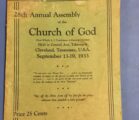
137: Number of God in Scripture and Science, Part II :: By Randy Nettles
The number 137 or 1/137 is well-known in the scientific community, especially in the fields of physics and quantum electrodynamics (QED). There’s a unique, non-dimensional atomic constant in physics known as “alpha” or the “Fine Structure Constant.”
Here is how Wikipedia describes it: In physics, the fine-structure constant, also known as the Sommerfeld constant, commonly denoted by α (the Greek letter alpha), is a fundamental physical constant that quantifies the strength of the electromagnetic interaction between elementary charged particles. It is a dimensionless quantity, independent of the system of units used, which is related to the strength of the coupling of an elementary charge e with the electromagnetic field, by the formula 4πε0ħcα = e2. Its numerical value is approximately 0.0072973525682 ≃ 1/137.035999206.
The brilliant physicist Richard Feynman (1918-1988) thought that this special number may well be the key to the fundamental structure of the universe around us. He called it “one of the greatest mysteries of physics: a magic number that comes to us with no understanding by man.” That magic number, called the fine structure constant, is a fundamental constant, with a value that nearly equals 1/137, or 1/137.035999206, to be precise. It is denoted by the Greek letter alpha – α.
What’s special about alpha is that it’s regarded as the best example of a pure number, one that doesn’t need units. It actually combines three of nature’s fundamental constants: The speed of light, the electric charge carried by one electron, and Planck’s constant. Appearing at the intersection of such key areas of physics as relativity (the velocity of light), electromagnetism (the electron), and quantum theory/mechanics (Plank’s constant) is what gives 1/137 its allure.
I am not a physicist or a mathematician, so the physics of the fine-structure constant is beyond my limited knowledge to explain. Since I can’t explain it adequately, I will just borrow this information (below) from Why the Mysterious Fine Structure Constant 137? | Evidence To Believe.
“One use of this curious number is to measure the interaction of charged particles like electrons with electromagnetic fields. Alpha determines how fast an excited atom can emit a photon. It also affects the details of the light emitted by atoms. Scientists have been able to observe a pattern of shifts of light coming from atoms called “fine structure” (giving the constant its name). This “fine structure” has been seen in sunlight and the light coming from other stars.
The constant figures in other situations, making physicists wonder why. Why does nature insist on this number? It has appeared in various calculations in physics since the 1880s, spurring numerous attempts to come up with a Grand Unified Theory that would incorporate the constant. So far, no single explanation has taken hold. If you’d like to know the math behind fine structure constant, more specifically, the way you arrive at alpha is by putting the 3 constants h (Planck’s constant), c (speed of light), and e (charge of electrons) together in the equation. (See the above link to view the math equation).
As the units c, e, and h cancel each other out, the “pure” number of 137.035999206 is left behind. For historical reasons, the inverse of the equation is used 2πe2/hc = 1/137.035999206. If you’re wondering what is the precise value of that fraction – it’s 0.0072973525682.
Why is this Number so Important?
The fine-structure constant controls how strong chemical bonds are, how we see light, and the vast majority of the things in the world. It also controls fusion in stars, which is important as that’s how all the chemical elements are created. It also governs the energy levels of an atom formed from negatively charged electrons and a positive nucleus. When electrons jump between these energy levels, they absorb and emit light of particular frequencies. These frequencies show up as lines (dark for absorption; bright for emission) in a spectrum. When many different energy levels are involved, as they are in the spectrum of a chemically mixed star, the result is a fine, comb-like structure—hence the constant’s name.
The fact that α is dimensionless has led some physicists to speculate that its value has some fundamental significance. It describes a fundamental property of the universe, and the question is whether its value is just an accident of how the universe happened to be put together, or whether its value is determined by some deep principle that we have yet to discover. (Could this be a hint at the Creator Himself?)
Scientists ask: “What is the reason for this peculiar number which appears to underpin the whole of nature?“ I submit that alpha takes on the precise value it has so that this universe, the solar system we abide in, and the earth itself and the laws which govern it, can be delicately fine-tuned for life. Our life. If the value of α varied even slightly more or less, life as we know it could not exist on this planet.”
Remember how we said that alpha (α) or the fine-structure constant’s numerical value is approximately 0.0072973525682 ≃ 1/137.035999206. Here’s something I found in The Mysterious 137 – Bible Gematria that is very interesting and can’t be a coincidence:
The number is required to know how specific wavelengths of light interact in precise ways with atoms and how electromagnetic forces hold atoms together. Hence we know that this number is one of the core factors that determine the size of the atoms and, therefore, the form and structure of the universe.
To calculate α, you start with the square of an electron’s charge, divide it by the speed of light and Planck’s constant, then multiply the whole lot by two Pi. The units of this number are coulombs, meters per second and joules per second, but they cancel out, leaving a dimensionless ratio, applicable in any measurement system.
The inverse fine-structure constant is essentially equivalent to 1/137, although the precise figure is 137.035999206… Remarkably, it can be approximated by these elegant equations: α ≈ 1/(cos(π/137)/137), and α ≈ 4π³ + π² + π, both with a 99.999% accuracy.
The close relationship between π and the fine structure constant can be seen by adding the sum of the squares of the first 7 digits of π: π = 3.141592… 3² + 1² + 4² + 1² + 5² + 9² + 2² = 137.
Here is a good YouTube video that explains the fine structure constant. The MYSTERIOUS NUMBER that Shaped our Universe! Fine Structure Constant – YouTube
Britannica.com defines photosynthesis as the process by which green plants and certain other organisms transform light energy into chemical energy. During photosynthesis in green plants, light energy is captured by a pigment and used to convert water, carbon dioxide, and minerals into oxygen and energy-rich organic compounds. The total number of atoms in the chlorophyll molecule, C55H72O5N4Mg, is 137 (55 + 72 + 5 + 4 + 1) = 137. All life on earth depends on this process of converting light into energy for its survival.
In the beginning, God created the heaven and the earth by His power (ul – Strong’s H193) and wisdom (hakma – Strong’s H2451). These two Hebrew words have a gematria of 37 and 73. 73 is the 37th odd number. The gematria of Genesis 1:1 is 2701, which is 37 x 73. 2701 is also the 73rd triangular number. The four-letter Hebrew word for wisdom, hakma, has a gematria of 5 + 40 + 20 + 8 = 73, and the place value of 5 + 13 +11 + 8 = 37. “The Lord by wisdom hath founded the earth; by understanding hath he established the heavens” (Proverbs 3:19).
In John 1:1, the Greek word Logos is translated as Word, which has a gematria of 373. The Word spoke the heavens and the earth into existence. The words “And God said” are used 10 (3² + 1) times in the creation account, 21 (3 x 7) total times in Genesis 1, and 30 total times in the Old Testament.
Genesis 1:1-4 has 39 Hebrew words. Genesis 1:4, “And God saw the light, that it was good: and God divided the light from the darkness,” has 12 Hebrew words. The word “the light” (the Hebrew word is “ha o wr”) is the 10th word in verse 4 and is the 37th word from Genesis 1:1. This 37th word starts with the 137th letter from the beginning of Genesis 1:1. Light is a very important part of the creation process. You have to remember that this was before the Sun was created on the fourth day. The light on the first day was supplied supernaturally by God Himself. Jesus said in John 8:12, “I am the light of the world: he that follows me shall not walk in darkness, but shall have the light of life.”
The Hebrew gematria of Genesis 1:4 is 1776. The 37th word in Genesis is “ha o wr,” the light. The Hebrew word “hayil” is used throughout the Old Testament and is translated as “strength or power.” Its gematria is 48. 37 (light) x 48 (power) = 1776, which is 2 x 888. The Greek word Jesous (Jesus) has a gematria of 888. By the Word’s (pre-incarnate Jesus) power, He brought forth light to start the creation process of life that was to follow.
Britannica.com describes String theory, in particle physics, as a theory that attempts to merge quantum mechanics with Albert Einstein’s general theory of relativity. The name string theory comes from the modeling of subatomic particles as tiny one-dimensional “stringlike” entities rather than the more conventional approach in which they are modeled as zero-dimensional point particles.
The number for Pi (the symbol is π) appears in many formulae across mathematics and physics. Pi is defined as a mathematical constant that is the ratio of a circle’s circumference to its diameter, approximately equal to 3.14159…(into infinity). So far, with the help of supercomputers, pi has been calculated to 62.8 trillion digits (and still counting). It’s interesting that when you divide 22 (the number of letters in the Hebrew alphabet) by 7, you get 3.14285…, which is close to pi.
The number Pi (3.14159…) has its own “string theory” of numbers, if you will. It has an infinite number of digits after the decimal point. With the help of supercomputers, it is now possible to explore and analyze these digits that are strung together (seemingly in a random manner) and see if there are any significant groupings of numbers. The Mysterious 137 – Bible Gematria has several examples of patterns and groupings of numbers that correlate with the gematria of some Bible verses. I highly recommend this website as it has some amazing gematria and scientific information. Below are some examples from their site.
The first three words in the Bible are Bereshith (In beginning), bara (created), and Elohim (God). Bereshith has a gematria value of 913. Bara’s value is 203. Elohim’s value is 86. When they are strung together, they are 91320386. The first occurrence of 91320386 in Pi is followed by the three digits 232. In the Bible’s third verse, God said, “Let there be light.” The gematria value of יהי אור (“Let there be light”) is 232. This numeric string of 91320386232 occurs at the 136,010,766th decimal of Pi. Coincidence? I’ll let you be the judge.
As I mentioned above, the Hebrew gematria of Genesis 1:1 is 2701, and the Greek gematria (Isopsephy) of John 1:1 is 3627. The first occurrence of this linked gematria, 27013627, in Pi, begins from position 62,418,439. If you add these digits (6 + 2 + 4 + 1 + 8 +4 + 3 + 9) together you get 37.
The Greek word for Jesus is Jesous (Χριστός), and has a value of 888. The Greek word for Christ is Christos (Χριστός), and has a value of 1480. 2701 (the gematria of Genesis 1:1) x 888 = 2,398,488. And therefore, 2 + 398 + 488 = 888. Also, 2701 x 1480 = 3.997,480. So, 3 + 997 + 480 = 1480.
Another remarkable proof from the gematria of Genesis 1:1 and John 1:1 is the discovery of the values of key mathematical constants to a high degree of accuracy. The calculation of transcendental numbers π and e, along with the fine structure constant, also known as alpha (α), attest to the authenticity of the text. The identical method to obtain π and e from separate creation accounts from different covenants is evidence of the oneness of the Bible and the hand of the Creator in its compilation.
To find the approximate value of Pi from Genesis 1:1, you take the total letters (28) x the product of the Hebrew gematria letters and divide that amount by the total words (7) x the product of the gematria words. The equation is: π = (28*2*200*1*300*10*400*2*200*1*1*30*5*10*40*1*400*5*300*40*10*40*6*1*400*5*1*200*90) / (7*913*203*86*401*395*407*296) = 3.14155E+17. Compare this number with the exact number for Pi of 3.14159…. Amazing!
To find the approximate value of e from John 1:1, you do basically the same thing as above, only with the Greek gematria of John 1:1. It would equate to this: 4.38685E+77 / 1.61381E+37 = 2.71831E+40. Compare this with the exact number for e of 2.71828…. Amazing!
To find alpha or the fine constant structure from the Bible, you link together the total Hebrew gematria values of Genesis 1:1 (2701) and the Greek values of John 1:1 (3627) and square them, which is 270136272, which = 7.29736E+14. Compare this with the number for alpha of 7.29735…. Truly amazing! The words of the first verses in the Books of Genesis and John may have been written by Moses (in Hebrew) and John (in Greek), but is there any doubt that the Holy Spirit was influencing their exact words, so the gematria numbers would align as they do, to prove the word of God is true and undisputable? God is the Great Designer/Mathematician of the eons!
I have only scratched the surface with this study. I recommend you check out the linked articles/websites I have mentioned if you can withstand the information without your head exploding. However, there is one more matter regarding the number 137 that I will leave you with. In a previous article, Going Forth of the Word to Return and Build Jerusalem :: By Randy Nettles – Rapture Ready, I presented my case for a 444 BC date for when the commandment or word was given to Nehemiah to go and build the city and walls of Jerusalem. In my opinion, this is the terminus a quo (start) for Daniel’s 70 weeks (sevens) prophecy in Daniel 9:24-27.
With this in mind, let’s examine the Hebrew gematria of some keywords in Daniel 9:25. “Know therefore and understand, that from the going forth of the word to restore and to build Jerusalem unto the Messiah the Prince shall be seven weeks, and threescore and two weeks: the street shall be built again, and the wall, even in troublous times.” The Hebrew word for “going forth” (KJV) is מוֹצָא or “mosa” (Strong’s H4161) and has a gematria value of 137. The Hebrew word for “word” (or matter) is דָּבָר or “dabar” (Strong’s H1697) and has a gematria value of 206. As I said in the article, dabar (words) matters, and therefore, numbers too.
It’s interesting that in my article, Sevens (rev310.net), I show where the start of Daniel’s 70 sevens prophecy begins in the 137th Shemitah year since the children of Israel entered the Promised Land. So, in other words, in 444 BC, the going forth (mosa -gematria of 137) of the word to restore and to build Jerusalem occurred in the 137th Shemitah year.
The terminus ad quem (end) of the 69th seven (Shemitah years) of Daniel 9:25 occurred in 33 AD, which I have listed in my article as in the 205th Shemitah year. If Jesus had been accepted as king of Israel on Nisan 10, 33 AD, the 70th seven would have started, and seven years later, the terminus ad quem would have been in the 206th Shemitah year. That would have been 70 sevens since the word (dabar – gematria of 206) went forth from the king of Persia to rebuild Jerusalem. Instead, the last seven years of Daniel’s prophecy have been on hold for 1990 years so far.
The same Hebrew word for “going forth,” mosa” (gematria of 137), is found in Hosea 6:3. “Then shall we know, if we follow on to know the Lord: his going forth is prepared as the morning; and he shall come unto us as the rain, as the latter and former rain unto the earth.” Jesus (as represented symbolically with the number 33) came to us the first time as the latter rain (during the spring season). He will return (go forth) to the earth the second time as the former rain (during the fall season). Isn’t it interesting that 137 is the 33rd prime number? My, my, so many coincidences!
Amen. Even so, come, Lord Jesus.
The Universe, and God’s word through biblical numerology and gematria, all declare the number of God is 137.
Randy Nettles
The post 137: Number of God in Scripture and Science, Part II :: By Randy Nettles appeared first on Rapture Ready.

